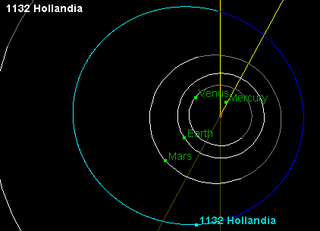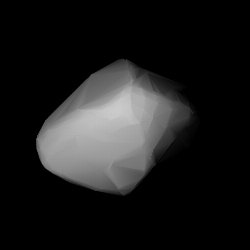4349 Tibúrcio, provisional designation 1989 LX, is a dark asteroid from the central region of the asteroid belt, approximately 29 kilometers in diameter. It was discovered on 5 June 1989, by German astronomer Werner Landgraf at ESO's La Silla Observatory in northern Chile.

1132 Hollandia, provisional designation 1929 RB1, is a stony asteroid from the middle region of the asteroid belt, approximately 27 kilometers in diameter. It was discovered on 13 September 1929, by Dutch astronomer Hendrik van Gent at Leiden Southern Station, annex to the Johannesburg Observatory in South Africa. It was named for the region Holland in the Netherlands.
1151 Ithaka, provisional designation 1929 RK, is a carbonaceous asteroid from the inner regions of the asteroid belt, approximately 14 kilometers in diameter. It was discovered by Karl Reinmuth at the Heidelberg-Königstuhl State Observatory in 1929, and later named for the Greek island of Ithaca.
6349 Acapulco, provisional designation 1995 CN1, is a dark Adeonian asteroid from the middle region of the asteroid belt, approximately 22 kilometers in diameter.
11277 Ballard (provisional designation 1988 TW2) is a Phocaea asteroid from the inner regions of the asteroid belt, approximately 6.3 kilometers (3.9 miles) in diameter. It was discovered on 8 October 1988, by American astronomer couple Carolyn and Eugene Shoemaker at the Palomar Observatory in California. The assumed S-type asteroid has a rotation period of at least 10 hours. It was named for American marine scientist Robert Ballard.

2708 Burns is a carbonaceous Themistian asteroid from the outer regions of the asteroid belt, approximately 19 kilometers in diameter. It was discovered on 24 November 1981, by American astronomer Edward Bowell at the Anderson Mesa Station near Flagstaff, Arizona, in the United States. It was named after American planetary scientist Joseph A. Burns. The likely elongated B-type asteroid has a rotation period of 5.3 hours.
1991 Darwin, provisional designation 1967 JL, is a stony Florian asteroid from the inner regions of the asteroid belt, approximately 5 kilometers in diameter.
3893 DeLaeter, provisional designation 1980 FG12, is an asteroid from the inner regions of the asteroid belt, approximately 12 kilometers in diameter. It was discovered on 20 March 1980, by British astronomer Michael Candy at the Perth Observatory in Bickley, Australia. The asteroid was named after Australian scientist John Robert de Laeter.
1267 Geertruida, provisional designation 1930 HD, is a carbonaceous background asteroid from the inner regions of the asteroid belt, approximately 20 kilometers in diameter. Discovered by astronomer Hendrik van Gent at Johannesburg Observatory in 1930, the asteroid was later named after Geertruid Pels, sister of Dutch astronomer Gerrit Pels.
2571 Geisei, provisional designation 1981 UC, is a stony Florian asteroid from the inner regions of the asteroid belt, approximately 6 kilometers in diameter. It was discovered by Japanese astronomer Tsutomu Seki at Geisei Observatory on 23 October 1981, and named for the Japanese village of Geisei.
2126 Gerasimovich, provisional designation 1970 QZ, is a stony background asteroid from the inner regions of the asteroid belt, approximately 8 kilometers in diameter. It was discovered on 30 August 1970, by Soviet astronomer Tamara Smirnova at the Crimean Astrophysical Observatory in Nauchnyj, on the Crimean peninsula. The asteroid was named after Russian astronomer Boris Gerasimovich.
2324 Janice, provisional designation 1978 VS4, is a dark background asteroid from the outer regions of the asteroid belt, approximately 25 kilometers (16 miles) in diameter. It was discovered on 7 November 1978, by American astronomers Eleanor Helin and Schelte Bus at the Palomar Observatory in California. The asteroid was named for Janice Cline at Caltech. The presumably C-type asteroid has a rotation period of 23.2 hours.
6255 Kuma, provisional designation 1994 XT, is a carbonaceous asteroid from the central region of the asteroid belt, approximately 22 kilometers in diameter. It was discovered on 5 December 1994, by Japanese astronomer Akimasa Nakamura at Kuma Kogen Astronomical Observatory on the Island of Shikoku, Japan. It was named after the Japanese town of Kumakōgen.
2173 Maresjev, provisional designation 1974 QG1, is a dark background asteroid from the outer regions of the asteroid belt, approximately 28 kilometers (17 miles) in diameter. It was discovered on 22 August 1974, by Soviet–Ukrainian astronomer Lyudmila Zhuravleva at the Crimean Astrophysical Observatory in Nauchnij, on the Crimean peninsula. It was named for Soviet war veteran Alexey Maresyev. The assumed C-type asteroid has a tentative rotation period of 11.6 hours.
1303 Luthera, provisional designation 1928 FP, is a dark asteroid and the parent body of the Luthera family, located in the outermost regions of the asteroid belt. It measures approximately 90 kilometers in diameter. The asteroid was discovered on 16 March 1928, by astronomer Friedrich Schwassmann at the Bergedorf Observatory in Hamburg, Germany, and later named after German astronomer Robert Luther.
1455 Mitchella, provisional designation 1937 LF, is a Florian asteroid, slow rotator and suspected tumbler from the inner regions of the asteroid belt, approximately 7 kilometers in diameter. It was discovered on 5 June 1937, by astronomer Alfred Bohrmann at the Heidelberg-Königstuhl State Observatory in southwest Germany. The asteroid was named after American astronomer Maria Mitchell.
1405 Sibelius, provisional designation 1936 RE, is a stony Florian asteroid from the inner regions of the asteroid belt, approximately 8 kilometers in diameter. It was discovered on 12 September 1936, by Finnish astronomer Yrjö Väisälä at Turku Observatory in Southwest Finland. The asteroid was named after composer Jean Sibelius.
3823 Yorii, provisional designation 1988 EC1, is a carbonaceous asteroid from the outer region of the asteroid belt, approximately 11 kilometers in diameter.
4760 Jia-xiang, provisional designation 1981 GN1, is a background asteroid from the inner regions of the asteroid belt, approximately 5 kilometers (3 miles) in diameter. It was discovered on 1 April 1981, by astronomers at Harvard University's Oak Ridge Observatory in Massachusetts, United States. The presumed stony S-type asteroid was named after Chinese astronomer Zhang Jiaxiang. It has a rotation period of 14.96 hours.

1422 Strömgrenia, provisional designation 1936 QF, is a stony Florian asteroid from the inner regions of the asteroid belt, approximately 5.5 kilometers in diameter. It was discovered on 23 August 1936, by German astronomer Karl Reinmuth at Heidelberg Observatory in southern Germany, and named after Swedish-Danish astronomer Svante Elis Strömgren.



